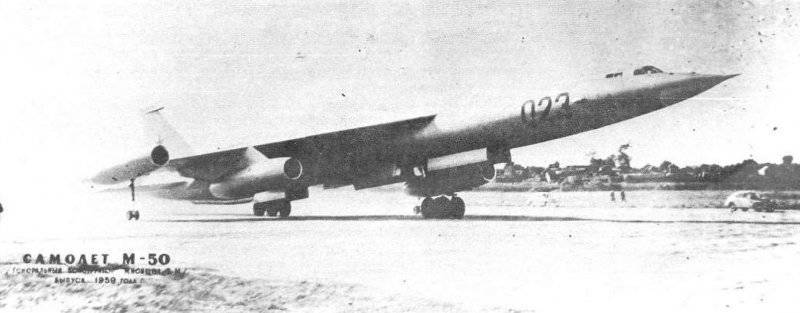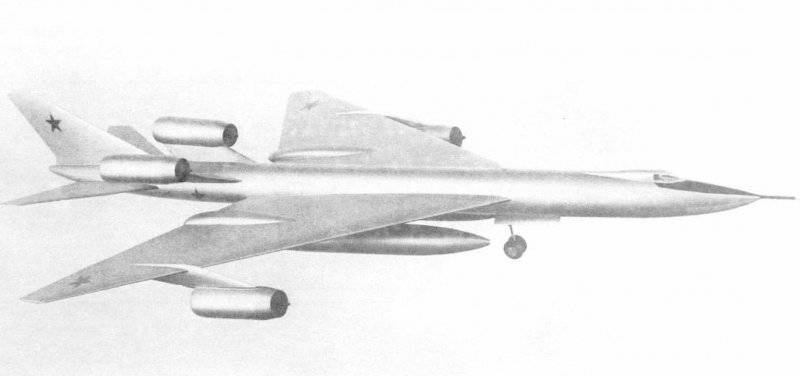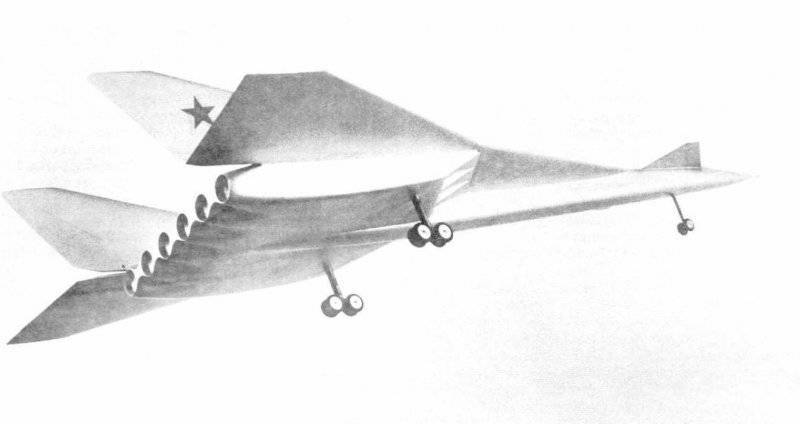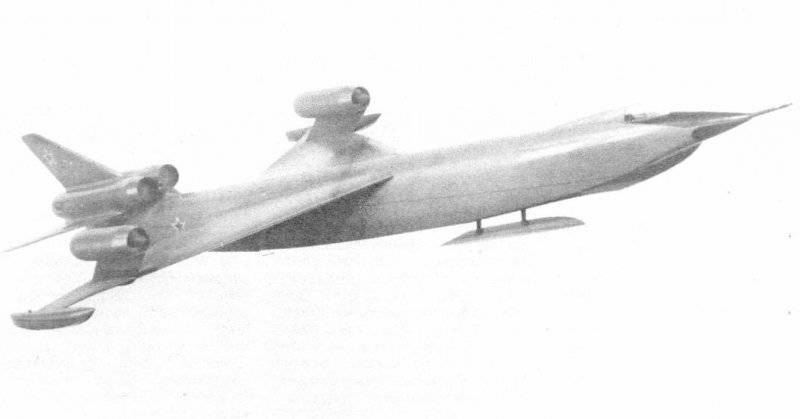M -50 - strategic bomber
In the USSR, various options for strategic bombers of the new generation were considered. One of the most original directions, developing only in our country, was the work on the creation of flying boats with intercontinental range. One of the significant advantages of this concept was the ability to replenish the fuel in the ocean, in the immediate vicinity of the enemy's coast, from surface ships and submarines. In addition, for seaplane bomber there was no need to build huge airfields with heavy-duty multi-kilometer concrete runways, which were excellent targets for the enemy's percussion aids.
In 1955, P.JI. Bartini, who was working at that time at SIBNIA (Novosibirsk), proposed two supersonic flying boat projects - A-55 and A-57. As conceived by the designer, the A-57 aircraft was a strategic integrated system, including the amphibian seaplane itself, capable of taking off and landing on the water surface, as well as on snow and ice (this allowed the use of forward-based airfields located on drifting ice floes in the Arctic) as well as a heavy guided missile of the RCC, which was created by the PVB Design Bureau. Tsybina and located on the aircraft carrier.
The aircraft was supposed to perform according to the “tailless” scheme with a pronounced integral arrangement (the fuselage itself was practically absent). The “self-balancing” wing (balancing achieved by swinging along the span) with minimal total wave and inductive resistance, having a variable sweep along the leading edge, had a supercritical downwardly convex profile in the center and a convex upward end. The wheeled chassis was absent, take-off and landing on ice and water were performed using a hydrolift retractable under the central part of the aircraft. For take-off from the usual airfield, it was supposed to use wheeled carts discharged from the ground. The crew of the aircraft was three people. A-57 had to carry the equipment necessary for autonomous operation in the ocean or on the Arctic ice floe: there was the necessary skipper equipment, a through passage along the entire boat, a latrine for the crew. All operations for the first priority maintenance of the bomber were performed within the boundaries of the wing and vertical tail, i.e. the plane could be serviced afloat.
The plane was supposed to equip the radar SVR-1, active systems REP "Rose" and "Broom", a system of setting passive interference TRS-45, navigation system "Wind", complex communications "Planet" and hydroacoustic communication system with submarines "Okhotsk".
The calculated maximum speed of the A-57 was 2500 km / h, the practical ceiling (depending on the flight mass) 18 000-23 000 m, the practical range 15 000 km.
The aircraft was supposed to be equipped with five NK-10B TRDFs (5 x 26 000 kgf) or NK-6 (5 x 22 500 kgf), placed with a package installed above the hull of the boat, in its tail between the keels tilted inwards. Above the engines a PCR cruise missile was to be installed, in addition, there was an internal cargo compartment to accommodate a thermonuclear bomb weighing 3000 kg.
To continue working on the project R.L. Bartini in April 1957 was seconded from SIBNIA to OKBS MAP (Moscow). TsAGI and CIAM teams are involved in work on A-57. Were investigated modes of takeoff of the aircraft from the water and the possibility of its long stay afloat. The MAP Commission, which was attended by representatives of TsAGI, TsIV 4AM, NII-1, OKB-156 and OKB-23, gave a positive opinion on the project, but the government’s decision to build the aircraft was not made.
The A-55 was a smaller version of the A-57, which had a medium range.
In 1961, the designer presented the design of the supersonic long-range reconnaissance P-57-AL - the development of A-57. Total from 1952 to 1961. R.L. Bartini conducted work on five projects of supersonic amphibian airplanes, made according to the “tailless” scheme - А-55, А-57, Р, Ф-57 (Р-57, front-line supersonic amphibious bomber having a ski landing gear) and Р-57AL On which installation of engines NK-6, NK-10 or VK-15М was supposed.
In the design bureau of VMMyasishchev in the second half of the 1950-ies, work was also carried out to create a supersonic M-70 flying bomber boat. The aircraft, made according to the normal aerodynamic configuration (variants with a swept wing and a trapezoidal wing, having a forward sweep on the leading edge and the opposite one - on the rear), were designed to be equipped with four TRDFs - two above the wing and two on the keel. For takeoff and landing should have been used retractable ski. The plane had to have a take-off mass of 240 t and reach a speed corresponding to M = 1,7. After closing in 1960, OKB V.M. Myasishchev's work on the M-70 was discontinued, although options for creating such bombers were also considered later, in the 1960s.
At the end of the 1950-ies, GM M. proposed a version of a strategic bomber - a flying boat. Beriev. The huge aircraft LL-600, made according to the “tailless” scheme with a delta wing, was supposed to be equipped with eight TRDs placed in two wing-wing “packages”. However, the huge mass of the aircraft (in one of the options - up to 1000 kg) made the possibility of its construction unlikely.
Another very exotic project was developed from 1955 under the leadership of P.V. Tsybin, who headed the OKB-256 State Committee for Aviation Technology (GKAT) under the USSR Council of Ministers. It was supposed to create a kind of two-stage system consisting of a carrier aircraft (at the first stage it was supposed to use a specially upgraded Tu-95H plane, and from 1956 in the AN Tupolev design bureau, a special carrier, 108, with a delta wing and able to reach speeds up to 1500 km / h). The second stage was to be a single-seat PC bomber capable of speeds up to 3000 km / h. It was supposed to equip Bondarenko designs with two twin engine accelerators and two direct-flow cruising engines (ramjet engines) (simultaneously in the design bureau of SM Lavochkin and VN Chelomey, the Kurya and Buran unmanned aircraft equipped with the same engines and having an intercontinental range at McR. = 3). The estimated total flight distance of the PC aircraft was 12 500-13 500 km.
The draft design was released on 31 on January 1956, but later it turned out that the heavy thermonuclear bomb (such ammunition weighed no less than 3000 kg), combined with the need to place the pilot with all the necessary life support systems for a few hours flight, do not allow meet the specified weight limits. This led to the reorientation of the design bureau to the creation of a high-speed high-altitude reconnaissance aircraft of the RSR, in the construction of which was used the technical groundwork obtained when creating the PC bomber.
Yet the main direction of development of strategic aviation remained the creation of supersonic land-based aircraft. One of the first to take up this task was V.M. Myasishchev. From 1952, in its design bureau, projects of supersonic M-30, M-31, M-32, M-33 and others (all around 20 projects were investigated) that did not have an intercontinental range were studied. In accordance with the instructions of the Deputy Minister of Aviation Industry from 4 in March 1953, the project of an M-34 supersonic (or, as it was written in the documents of that time “supersonic”) aircraft with a take-off mass of 180 000 kg and cruising speed 1350-1450 km / h was worked out. , flight altitude over the target 17 000 m and practical range 8000 km (calculated data for this aircraft were presented in the MAP 10 March 1953 g.).
In 1956, the bureau began the creation of a strategic aircraft with an intercontinental range of M-50, intended to replace the ZM bomber. In a relatively short time, a unique for those times aircraft was designed and built, designed to achieve speed close to M = 2 and intercontinental flight range. The decisive role in the creation of the M-50 was played by such experts of the Myasishchev OKB as L.L. Selyakov (chief designer of M-50), JI.I. Balabuh, I.B. Zaslavsky, L.M. Rodnyansky, V.A. Stopachinsky, V.A. Fedotov. The largest scientists of TsAGI, MV, also took part in the work on the program. Keldysh, A.I. Makarevsky, G.S. Buchgens and others. Together with TsAGI, more than 30 variants of the aerodynamic layout of the aircraft were analyzed, in particular, the aircraft designed according to the “weft” scheme with a thin (relative thickness 3,5- 3,7%) triangular wing, swept all-rotary horizontal and vertical plumage. The design of the aircraft provided the possibility of a long flight at low altitude at high speed.
The wing was made using monolithic extruded panels. The fuel is located not only in fuselage tanks, but also under the delta wing, two-fin tail and four engines on the underwing pylons, as well as the aircraft, made according to the normal scheme with a swept wing, two engines on the underwing pylons and two - on short pylons in the rear fuselage .
The four-wheeled cart of the bicycle chassis “billowing up” turned around an axis at a certain speed at the takeoff, while the front pair of wheels went up, the angle of attack increased, and the length of the run significantly decreased.
CHARACTERISTICS OF STRATEGIC BOMBERS - “FLYING BOATS” | ||||
Aircraft type | A-57 | M-70 | PL-600 | |
Project submission year | 1957 | 1959 | end of 1950 | |
Mass of fuel kg | — | 144 000 | — | |
Maximum takeoff weight | kg | 250 000 | 240 000 | 1000 |
Maximum speed km / h | 2500 | 1800 | 900 | |
Practical range km | 12 000 | — | — | |
For braking the aircraft during the run, four ski-like steel beams were used, with the help of a hydraulic system pressed against the "concrete". The variant of dumping after take-off of two wheels of each rack was also worked out: the landing weight is much less than the take-off, and when landing you can get by with four wheels instead of eight, however the designers' concerns caused the possibility of destruction by the dropped wheels of the airfield structures.
For the first time in the practice of domestic aircraft construction, an analogue fully automatic EDSU was applied (on the first prototype aircraft, it was duplicated by rigid mechanical wiring, which was later to be dismantled).
Together with TsAGI, an automatic system was developed that regulated the position of the aircraft's CG when switching to supersonic mode by pumping fuel from fuselage tanks. There was an automatic sustainability system. AC electrical system.
The crew of the M-50 consisted of two people sitting in tandem in the cockpit of the "fighter" type. To test the control system in various flight modes, a simulator stand was created in the OKB.
Bomb armament with a maximum mass up to 30 t was located in a large cargo compartment, where it was also supposed to suspend the M-61 guided cruise missile with folding planes, which had a launch range of up to 1000 km and also created in the Myasischev design bureau. The possibility of equipping the aircraft with a RCC heavy cruise missile P.V. Tsybina. At the first prototype, there was no defensive armament; on serial aircraft, the use of aft gun mount with remote control was assumed.
The power plant was planned to use TRDF, "16-17" (4 x 17 000 kgf), developed under the guidance of P. Jaws, which should have been outstanding for those times fuel economy (specific fuel consumption at M = 1,8 should have been 1,1 -1,2 kg / daNh) However, due to the engine's lack of knowledge on the prototype plane, the Dobrynin turbofan was installed as a temporary measure: on the pylons under the wing two turbofan engines VD-7 with afterburner chambers (2 x 14 000 kgf) and two unformatted VD-7B engines (2 x XNUM) were installed. kgf) placed on the end parts of the wing (the option of equipping the aircraft with advanced engines of V. Dobrynin VD-9750 was also studied).
In the autumn of 1958, the M-50, in a disassembled form, was taken by barge along the Moscow River from Filey to the LII airfield in Zhukovsky.
The first flight of the prototype took place on October 27 1959 (flew N.I. Goryainov and A.S. Lipko). 9 July 1961. The aircraft was spectacularly demonstrated at the aerial parade in Moscow (this was the last flight of the M-50 bomber). During the flight tests, due to the lack of design engines, the supersonic speed was not reached (only M = 0,99 was obtained).
Shortly after the start of work on the M-50, the OKB began to create a modification of it - the M-52, which has advanced missile weapons (the 4 SD was located on the sides of the fuselage in accordance with the area rule and slightly reduced the aerodynamics of the bomber), the end engines also installed on pylons, vertical tail feathering, small additional horizontal planes at the end of the keel, a refueling post in the forward part and a crew enlarged to 4 people. The aircraft, equipped with "regular" TRNF "16-17", was designed both for cruising at supersonic speeds at high altitude and for breaking through enemy air defenses at low altitudes (for the first time in the world for a strategic bomber a similar task was set). M-52 was built in 1959, but was not tested due to the closure of the OKB VM in 1960. Myasishchev. For a long time, it was stored in the parking lot of EMZ and was dismantled for metal at the end of the 1970s.
The M-54 project was also being worked out, having a wing of a modified shape and a slightly different arrangement of the engine nacelles.
A further development of the M-50 and M-52 aircraft was the M-56 bomber, the technical design of which was started in 1959. The aircraft was supposed to be designed according to the “duck” scheme with a wide-body fuselage, on the sides of which six KV-15 VK engines were installed. in two "packages" to which small rotary consoles were attached. VET, freely oriented at subsonic speeds, was rendered far ahead. The maximum design speed corresponded to M = 3,25, the maximum flight range - 10 000-12 000 km. A full-scale mock-up of the new aircraft was built, as well as flying radio-controlled bomber models.
On the basis of the M-56 aircraft, it was supposed to create a passenger supersonic aircraft M-53 (several variants of such a machine were worked out). However, the closure of work on manned aircraft and the dismantling of the design bureau of VM. Myasishchev put an end to the work on M-56 and its modifications.
OKB A.N. Tupolev also led work on projects of supersonic strategic bomber. At the end of the 1950-ies, almost simultaneously with the M-56, there was proposed the design of the aircraft "135", made on the aerodynamic "duck" with a delta wing and power plant, consisting of four engines NK-6 (4 x 22 500 kgf ). At the beginning of the 1960s, another, seemingly absolutely incredible, project of a supersonic aircraft with four theaters was considered. The aircraft was supposed to perform the normal aerodynamic scheme with a swept wing.
CHARACTERISTICS OF THE SUPER-SOUND STRATEGIC BOMBER 1950 — 60-s. | |||||
Aircraft type | «135» | M-50 | M-52 | M-56 | XB-70 |
Year built | project | 1959 | 1960 | project | 1964 |
Crew, people. | — | 2 | 4 | — | 4 |
Power point | |||||
(number of engines x thrust, kgf) | X 4 22500 | X 2 9750 | 4h 17000 | 6 х14000 | 2x14000 |
Wingspan, m | — | 35,10 | — | — | 32,00 |
Aircraft length м | — | 57,48 | — | — | 57,61 |
Aircraft height м | — | 8,25 | — | — | 9,14 |
Wing area m2 | — | 290,60 | — | — | 585,02 |
Maximum | |||||
take-off weight kg | 205 000 | 200 000 | 210 000 | 250 000 | 244 200 |
Weight of combat load kg | — | 30 000 | 30 000 | — | — |
Maximum speed km / h | 2200 | 1950 | 1950 | 3400 | 3220 |
Practical ceiling м | — | 16 500 | — | — | 21 300 |
Practical range | |||||
flight, km | 10 000 | 7400 | 10 000 | 12 000 | 12 000 |





Information